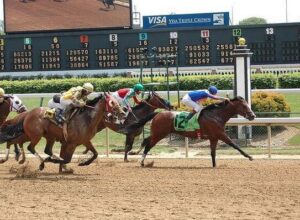 In the thrilling spectacle of the Grand National steeplechase, the maximum number of horses permitted to participate stood until recently at 40. This threshold was established in 1993, following a momentous race where a record-breaking 66 runners took their place on the starting line, etching their names into the race’s history books. The decision to impose this limit was motivated by a sincere commitment to prioritise safety, as the Grand National has been marred by unfortunate fatalities throughout its legacy. To further improve safety, in October 2023 the number was again cut to 36. It’s still a significantly sized field though, allowing for those taking advantage of free bets and the like to win big.
In the thrilling spectacle of the Grand National steeplechase, the maximum number of horses permitted to participate stood until recently at 40. This threshold was established in 1993, following a momentous race where a record-breaking 66 runners took their place on the starting line, etching their names into the race’s history books. The decision to impose this limit was motivated by a sincere commitment to prioritise safety, as the Grand National has been marred by unfortunate fatalities throughout its legacy. To further improve safety, in October 2023 the number was again cut to 36. It’s still a significantly sized field though, allowing for those taking advantage of free bets and the like to win big.
Undoubtedly, the Grand National demands a supreme level of readiness and athleticism from its equine contenders. Spanning an arduous distance of 4 miles and 2½ furlongs (equivalent to a staggering 6.907 kilometres), the race presents a formidable challenge for both horse and rider alike and is a nationwide betting opportunity for punters to get one over on bookmakers. Over the course of two captivating laps, the courageous horses must navigate a formidable array of 30 fences, renowned as some of the most formidable obstacles in the world of steeplechase. For those equine athletes not adequately prepared for this formidable test, the risks lurking within the racecourse can prove treacherous.
The introduction of the cap on the number of participants has sparked spirited debates, with proponents of an open field arguing that it curtails opportunities for horses to partake in this momentous event. However, the paramount concern remains the safety and welfare of these majestic creatures. By implementing this limitation, the race organisers have successfully curbed the incidence of fatalities, reinforcing their unwavering commitment to preserving the physical well-being of the equine competitors.
The Grand National, a captivating blend of spectacle and athleticism, continues to enthral audiences around the world. Through conscientious measures aimed at enhancing safety, this renowned steeplechase strives to ensure that the majesty of the race endures while minimising the inherent risks associated with its unforgiving nature. If there’s one race the nations eyes and money are on it’s the Grand National and so these efforts make sense. For those who can’t wait for the next National for a flutter, there are many sites offering Free Horse Racing Tips For Today, as way of guiding punters to winning selections.
 After winning such a huge amount of money, many EuroMillions jackpot winners decide to remain anonymous, and the Weirs certainly considered doing the same, but if no one knew where their funding came from, sharing the blessings with others would be difficult.
After winning such a huge amount of money, many EuroMillions jackpot winners decide to remain anonymous, and the Weirs certainly considered doing the same, but if no one knew where their funding came from, sharing the blessings with others would be difficult. Horse racing, a long-standing tradition, has etched itself deeply into the cultural identity of Kentucky. In this region, this sport goes far beyond a mere pastime—it’s a historical legacy. The strong tie between the state of Kentucky and horse racing is deep-seated, dating back centuries.
Horse racing, a long-standing tradition, has etched itself deeply into the cultural identity of Kentucky. In this region, this sport goes far beyond a mere pastime—it’s a historical legacy. The strong tie between the state of Kentucky and horse racing is deep-seated, dating back centuries.